How to go from tons of Excel and email to well organized RFQ and Purchasing process
Embark on a journey from tangled Excels and cluttered spreadsheets to a seamlessly organized Bill of Materials (BOM) with our expert guidance. Dive into captivating customer stories, enlightening videos, and insightful examples below. Ready to revolutionize your BOM management? Click the “Buy OpenBOM” button and join the ranks of over 1000 engineers who have already liberated themselves from spreadsheet chaos. With OpenBOM, you’ll transform the way you handle BOMs, simplifying cost calculations, enhancing team collaboration, streamlining communication with contractors and suppliers, and optimizing RFQ and purchasing processes. It’s time to embrace efficiency and elevate your workflow with OpenBOM.
OpenBOM will help you to move from messy Excels to well organized BOM management and purchasing process
What Customers Are Saying About OpenBOM?
Learn from our customers how OpenBOM has changed their way of managing Bills of Materials and collaborating with suppliers and contractors.
1. Pierson Workholding
Pierson Workholding is Using OpenBOM For A Complete Design To Manufacture In-house Process. OpenBOM Order BOMs and POs automatically created.
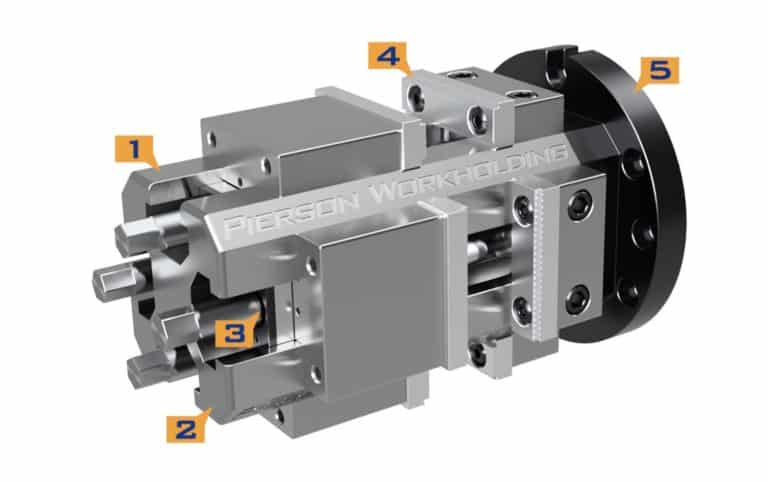
“We looked at a lot of options for creating and managing Bill of Materials, the CAD based product didn’t have the ability to create Planning BOMs and Purchase Orders (which we need) and Excel didn’t have any connection to our design process (CAD), which we also required,” says Carlos. “OpenBOM offers a complete Design to Purchase process which includes BOM, Order (planning) Planning BOMs, Vendor Lists and Purchase Orders. As well as inventory control of Quantity on Hand”
Carlos goes on to say “OpenBOM was easy to implement and setup. After a few 30 minute meetings with the OpenBOM support team, I had a functional configuration for a production test, created actual PO’s, and also used the Order BOM feature to create setup data for the circuit board assembly process. Adding additional properties with drop-down list selections allows me to capture setup data related to each part. That data is easily sorted and parsed into actions needed to get a PCB manufactured.”
Join 1000+ engineers using OpenBOM…
2. NYRIAD
New Zealand NYRIAD is building data centers for the future. Read NYRIAD story online.
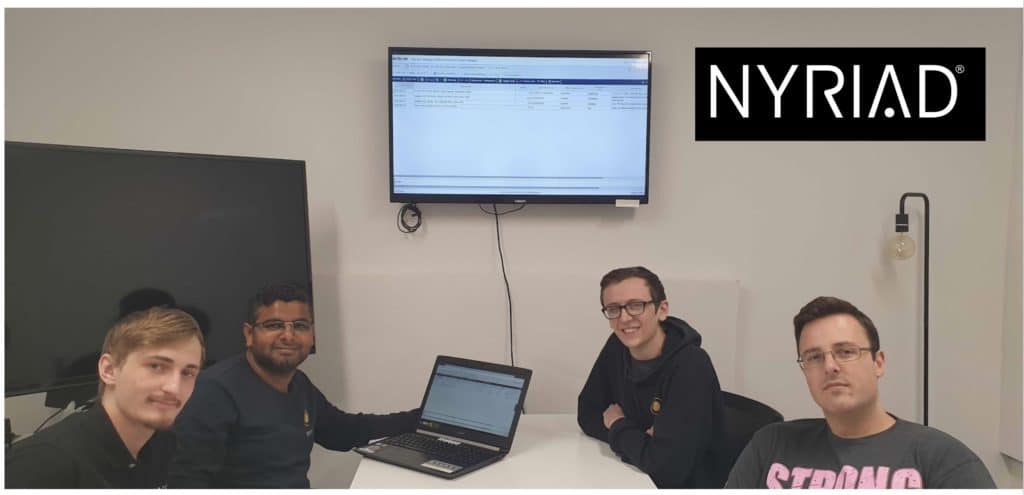
Now Nyriad not only stores all specifications and related documentation in OpenBOM, but relies heavily on the manufacturing features in OpenBOM. “We love the BOM Multi-Level and Flatten capabilities as well as Catalog part number creation function” Manu goes on to say.
“Flatten analyzes a complex BOM and tells us exactly how many of which components we need at the client’s site”.
Now Nyriad not only stores all specifications and related documentation in OpenBOM, but relies heavily on the manufacturing features in OpenBOM. “We love the BOM Multi-Level and Flatten capabilities as well as Catalog part number creation function” Manu goes on to say. “Flatten analyzes a complex BOM and tells us exactly how many of which components we need at the client’s site”.
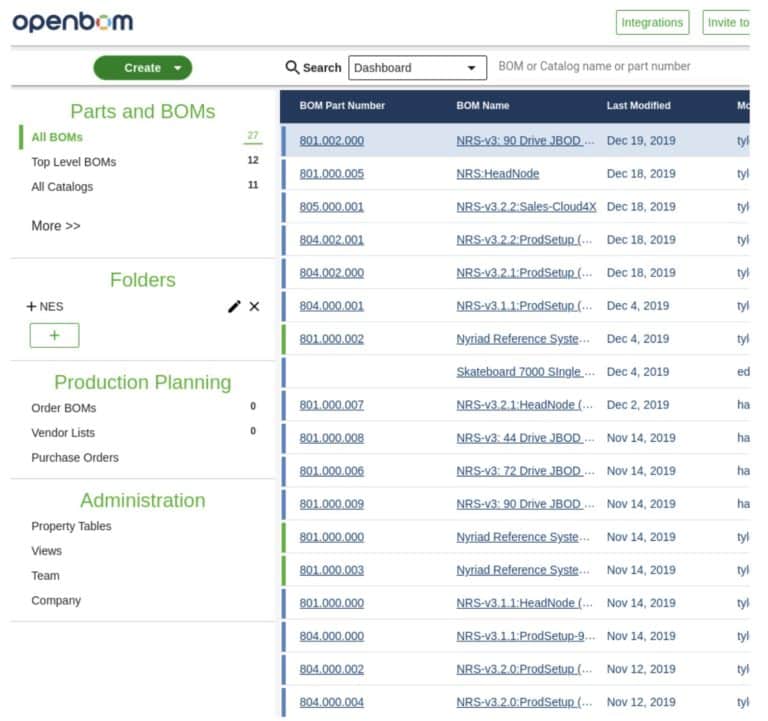
Rachel Kelly, Nyriad Head of Marketing and Global IT Insight describes how Nyriad’s software unifies the four essential elements required to efficiently process and store data: CPU, GPU, Memory, and Storage. “Trying to unify those 4 key components is hard ” she adds. “OpenBOM helps us keep track of the underlying infrastructure that supports this unification.”
Join 1000+ engineers using OpenBOM…
3.Response Biomedical Canada
Read the story by navigating this link. Mark Nah, Response Biomedical (Canada) speaks about his experience of how OpenBOM was helping to switch from Parts and Vendors to OpenBOM.
“When I get into forums discussing the end of life issues with Part and Vendors (P&V), no one was able to identify a suitable replacement. There is an opportunity here to enter forums specific for ex-P&V users to market OpenBOM. I find OpenBOM a very suitable replacement for Parts and Vendors. The data can be easily ported over from P&V. As I migrate over, one of my concerns is that “what-if”. What if OpenBOM decide to change business tack and I find myself again in the same situation with Trilogy. Being able to re-export the data out from OpenBOM is my insurance against that.”
Join 1000+ engineers using OpenBOM…
3. Stone Aerospace
Stone Aerospace is tracking BOMs, RFQs and Purchase Orders using OpenBOM. Read the story here
The folks at Texas-based Stone Aerospace are modern age explorers! Their team of seasoned expeditionary scientists and explorers develop the tools needed to explore, survive and work in the most extreme environments imaginable. The SUNFISH® vehicle was developed in collaboration with NASA for a future exploratory mission to the Jovian moon, Europa. This autonomous underwater vehicle is designed to explore the ocean beneath more than 15 km of ice and gather data autonomously from the alien world.

“Before OpenBOM we had no system for tracking PO’s, RFQ’s and BOM’s. We really had almost no PO system. With the implementation of OpenBOM we can actually follow the design cycle from cradle to grave, know when parts are due, costs of those parts and the stock status. That to me is a lot more impressive than just decreasing PO creation time.”
Join 1000+ engineers using OpenBOM…
4. LayerShift Project
The LayerShift project was manually capturing BOMs and related information for Marc Schömann’s 3D printer design using Autodesk Fusion 360. In order to manage the messy information, he needed to organize it into a manageable format. OpenBOM gives him this opportunity and data now is completely under control allowing him to manage BOMs and coordinate purchases.
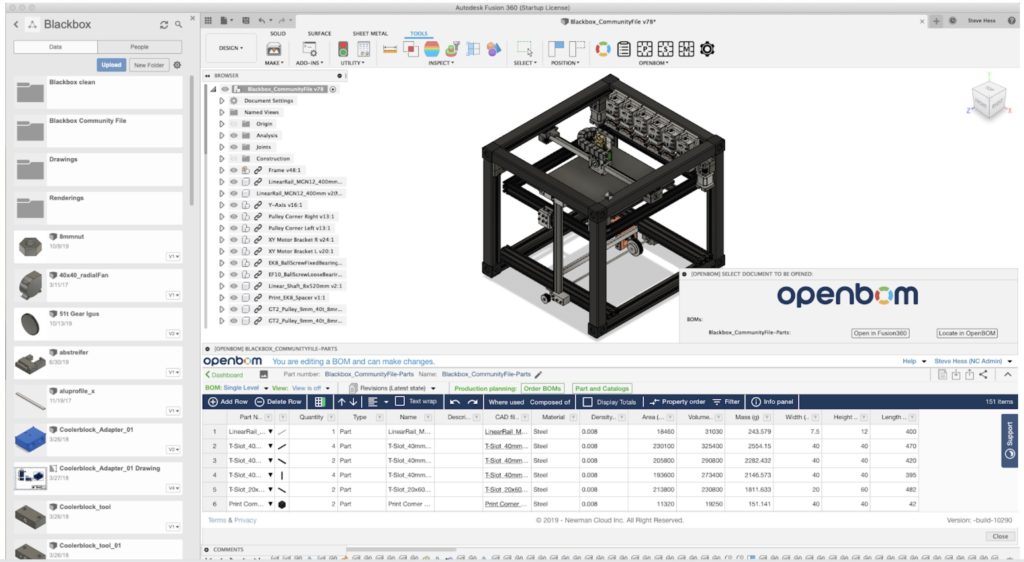
“Our distributed team used OpenBOM to capture product structure and assembly and part data from Autodesk Fusion 360 then create bills of material for purchasing the components we needed to build the printer,” Marc said. “The OpenBOM Fusion 360 integration made it easy to create and update BOMs and Part Catalogs and to identify and specify vendors as the design moved forward.”
Join 1000+ engineers using OpenBOM…
Is Excel or Google Spreadsheets not cutting it for managing your RFQs, purchases, and orders?
As an engineer, purchasing manager, or RFQ manager, the pressure to keep costs down and deliver products on time is constant in today’s fast-paced world.
While your company thrives on innovation, you’re stuck wrestling with endless Excel files, juggling parts, quantities, and rollup costs just to create RFQs and POs. Communication breakdowns with other teams and departments only add to the stress, making it difficult to coordinate orders and manage purchasing effectively.
You’ve experimented with different spreadsheet templates and even tried Google Sheets, but as your needs grow, so does the complexity. Spreadsheets struggle to handle nested structures and efficiently share and update data, leading to redundancy, errors, and missed updates—ultimately impacting production targets.
Meanwhile, the rise of Software as a Service (SaaS) solutions is transforming the cloud computing landscape, offering significant advantages in terms of innovation, engineering performance, and operational efficiency. Tech-Clarity research indicates that cloud/SaaS software adoption leads to greater value and competitive advantage across various business dimensions.
Continuing to rely on outdated Excel spreadsheets exposes you to costly mistakes, production delays, and missed opportunities for innovation. Embracing SaaS solutions for engineering and manufacturing not only mitigates these risks but also drives operational excellence and cost savings.
Don’t let your reliance on legacy solutions hinder your company’s growth and competitiveness. Make the switch to cloud-based SaaS solutions like OpenBOM to streamline your processes, improve collaboration, and stay ahead of the competition.
Yes, there’s a way out of the Excel maze…
The truth is, you can liberate yourself from the chaos of messy Excels and put an end to manual Bill of Materials (BOM) calculations by automating RFQ and PO organization. But here’s the catch – most software options lack the distinctive functionalities and capabilities found in OpenBOM.
OpenBOM offers a one-of-a-kind solution to transform your BOM management, allowing you to effortlessly create an Order BOM for your production batch and streamline related tasks in under fifteen minutes. This is made possible by the unique technologies and CAD integrations developed exclusively at OpenBOM.
Join 1000+ engineers using OpenBOM…
The OpenBOM Story
Before delving into the step-by-step guides, let me provide some insight into our company’s background.
For those unfamiliar with me, I’m Oleg Shilovitsky, boasting over 20 years of experience in developing PDM and PLM software for esteemed industry players like Autodesk and Dassault System. Additionally, I co-founded a previous startup, which was acquired by Autodesk in 2012.
For the past 12 years, I’ve been running a daily blog called Beyond PLM (beyondplm.com), sharing my expertise and insights into engineering and manufacturing software. Prior to launching OpenBOM, I held a position at Autodesk, where I spearheaded data management and PLM system development initiatives.
Established in 2015, OpenBOM was founded by individuals with a track record of success at industry giants such as Dassault Systems, Autodesk, HP, EMC, and others.
Having encountered the challenges of using Excel and costly PLM and ERP software firsthand, I envisioned OpenBOM as a solution to revolutionize PLM and BOM management using cutting-edge cloud/SaaS technologies.
At OpenBOM, we recognize the strategic importance of integration with engineering and manufacturing software. From day one, we’ve prioritized partnerships with CAD, PLM, and ERP companies to ensure seamless integration between their systems and OpenBOM.
Since our inception in 2016, OpenBOM has been empowering tens of thousands of manufacturing companies and engineering teams worldwide with our innovative platform.
Join 1000+ engineers using OpenBOM…
Imagine OpenBOM as a Google Spreadsheet supercharged with extensive capabilities in Bill of Materials, PLM, and ERP functionalities.
During my tenure managing product development teams, I experienced firsthand the benefits of collaboration using shared Google spreadsheets. The ability to access and update project details, action plans, and more in real-time streamlined our workflow significantly. This realization sparked the idea for OpenBOM – a platform designed to replicate and enhance this collaborative experience for product development teams.
Here is a foundation of OpenBOM:
1- OpenBOM supports a continuous process for managing Bill of materials, Planning (Order BOM), and Purchase Orders.
Here a snapshot of the process
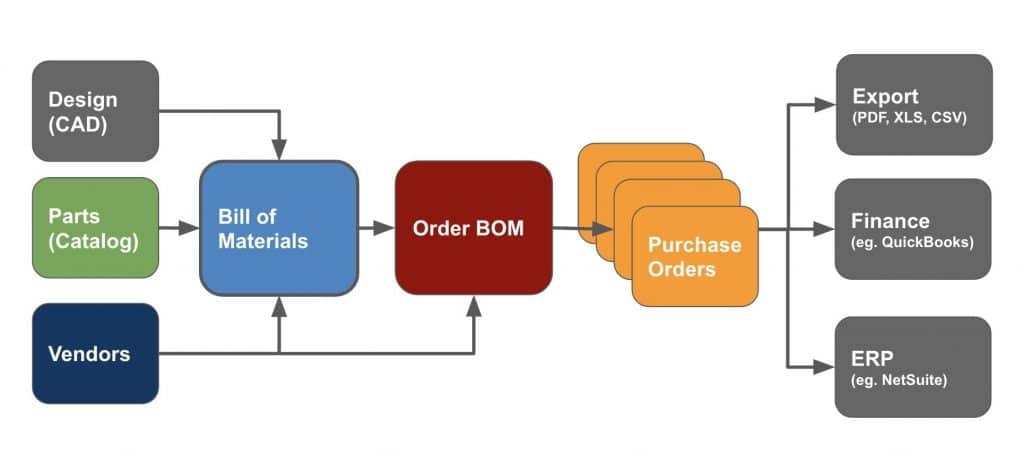
Here is a foundation of OpenBOM process:
Production planning can be thought of as the process, end-to-end, of using your BOM to buy the parts you need. Video of planning process.
- Assign vendors to items in Catalog
- Calculate quantities based on Bill of Materials for specific product batch
- Manage inventory of parts by controlling Quantity on Hand
- Organizing Order BOM to provide a summary of what needs to be purchased from which vendors
- Automate preparation of Purchase Orders to help sourcing parts and contract work
2- An easily accessible online application, now referred to as Software as a Service (SaaS), accessible from any browser.
OpenBOM is accessible worldwide through any web browser, operating on a highly secure infrastructure provided by Amazon Web Services (AWS). Users can create an account and gain instant access to the platform. Our global user base spans from San Francisco to Australia and New Zealand, as depicted on the map available on our website. Please note that we no longer update the image as it became challenging to distinguish individual dots in Europe and North America due to our widespread usage in these regions.
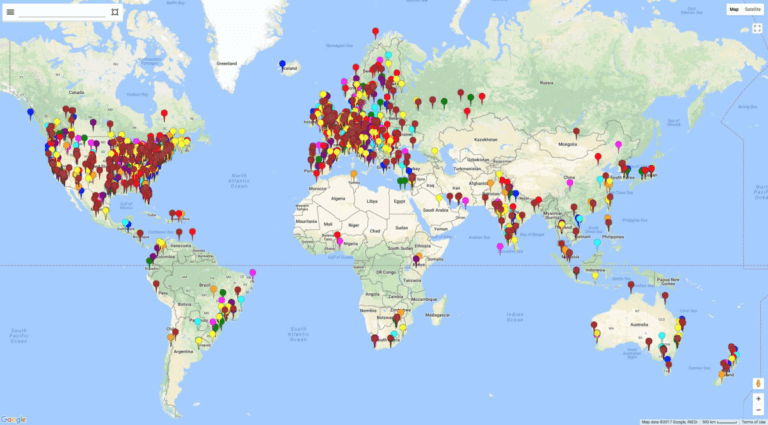
3- Enjoy a user experience as intuitive as Excel or a spreadsheet when it comes to organizing data, performing calculations, and conducting searches.
Explore the OpenBOM user interface, which resembles Excel in appearance and functionality, yet operates on a sophisticated database system hidden beneath its simplicity. With OpenBOM, you can easily add or delete columns, rearrange their order, incorporate formulas, and perform virtually all tasks you would typically do in Excel. Behind the scenes, these operations seamlessly translate into structured product data management.
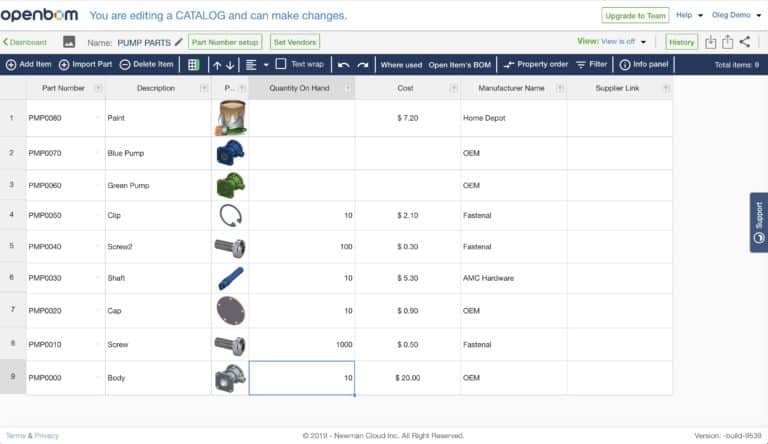
4- Empower your product information management with OpenBOM’s robust data model.
The OpenBOM information model boasts several key features to streamline data management:
(a) Reference instances prevent data redundancy, eliminating the need to copy the same information multiple times across different spreadsheets.
(b) Hierarchical nesting allows for the creation of multi-level BOMs, a task that can be cumbersome and error-prone in Excel.
With OpenBOM, you can organize your data akin to catalogs, creating a centralized database of all your standard parts, materials, and assemblies. These catalogs contain essential information such as descriptions, manufacturers, costs, and suppliers. Additionally, the Bill of Materials functionality enables the creation of a hierarchical product structure. Seamlessly switch between Multi-level and Flattened BOM views to experience the versatility of BOM management with the familiar ease of Excel.
Read more OpenBOM Training Library – Understand OpenBOM.
5- Integration with CAD tools.
It is a pain to get data out of engineering tool and all engineering web applications in the past were lacking good CAD integrations.
OpenBOM is integrated with ALL mechanical and electronic CAD systems. Take a look at the OpenBOM website integration page. We can easily extract information from your design and put it on OpenBOM. Even more, we will merge /update this information when your design will change.
Check what CAD integrations OpenBOM supports today.
6- Seamlessly capture changes and efficiently manage revisions with OpenBOM.
In Excel, tracking changes and managing revisions can be challenging, but with OpenBOM, it’s an integrated function designed to simplify your workflow.
OpenBOM automatically records all changes, alleviating any concerns about manual tracking. Every modification is logged in the system’s history, providing a transparent audit trail of who made what changes and when. Additionally, OpenBOM offers a specialized revision mechanism that enables you to maintain immutable snapshots of your BOM revisions at any given moment. This mechanism works seamlessly with the hierarchical structure, eliminating the complexities associated with managing the history of product structures.
With OpenBOM, you can effortlessly stay on top of changes and revisions, ensuring clarity and accuracy throughout your product development process.
7- Visual, easy to share and export.
The value of information lies in its ease of downstream sharing. That’s why we’ve made it “open” with OpenBOM – effortlessly shareable and consumable.
Similar to Google Sheets, our sharing function operates seamlessly. With a simple click, you can make your BOM or any other piece of information accessible to anyone you choose. Whether it’s colleagues within your company or external contractors and suppliers, you have the flexibility to control who can access specific columns and data. Our robust Team view feature further enhances data-sharing options, putting you in control.
Join 1000+ engineers using OpenBOM…
Here’s what you’re likely wondering:
1. Is it secure to store data in OpenBOM?
Yes, it’s as safe as an online bank. Our infrastructure on AWS is highly secure, and we prioritize the utmost security and privacy. You can review our terms and privacy statements on our website.
2. Will everyone have access to my data?
No, your data is securely accessed only by you using your login and password. Until you choose to share the data, nobody else has access to your information.
3. Can I retrieve my data if I decide to leave OpenBOM?
Absolutely. You can download your data at any time.
4. Will it be compatible with my CAD system version?
We offer out-of-the-box support for most CAD system versions, including Solidworks, Fusion360, Onshape, Inventor, Solid Edge, and others. If you encounter any issues with your CAD system version, please reach out to support@openbom.com, and we’ll address the problem promptly.
Join 1000+ engineers using OpenBOM…
All you need to do to escape from messy Excels is to follow these steps:
- Head to openbom.com and sign up for your free OpenBOM account.
- Gather all the Excel files you currently use to manage your parts and inventory data, as these are perfect for importing your catalog information into OpenBOM.
- Import your data into OpenBOM and experience the convenience of having a single source of truth for all your parts.
- Install the OpenBOM plug-in for your preferred CAD system.
- Generate your first BOM directly from CAD or Excel.
- Utilize built-in features like flattened BOM, rollups, and formulas to streamline your processes.
With these steps, you’ll be able to create your first BOM in just minutes. Once you’ve made the switch, you’ll never want to go back to Excel or spreadsheets again.
Take your OpenBOM experience to the next level by:
- Building a library of images for your parts to enhance the visual appeal and reduce errors.
- Planning your catalogs to effectively organize part classifications and distribution among contractors and suppliers.
- Considering how your team will access OpenBOM and upgrading to a Team subscription for unlimited users and the ability to organize Team Views.
- Managing part numbers and lifecycle by upgrading to a Company subscription, which allows you to oversee company catalogs and ensure part number uniqueness.
- Exploring OpenBOM’s integration with ERP and accounting software to streamline your operations.
- Automating OpenBOM with REST API to receive notifications and reports directly to your email or messaging apps like Slack.
Join 1000+ engineers using OpenBOM…
What Steps Should You Take Next?
I understand that change can be daunting, especially when it comes to moving away from Excel, which you both love and hate. Transitioning an entire company to a new solution can indeed be challenging. Perhaps you’re considering sticking with Excel despite its limitations, or maybe your existing PDM system seems like it could address your needs. These are valid concerns, and let’s address them:
1. Transitioning from Excel to OpenBOM:
Pushing your entire company to switch from Excel to OpenBOM all at once isn’t necessary. Take an agile approach and consider implementing changes in stages. Start by organizing your data and extracting BOMs with OpenBOM, then simply export them to Excel or PDF files to share with others. This way, there’s minimal disruption for your colleagues, but they’ll likely become curious about your organized and visually appealing BOMs. As they become more comfortable, you can gradually transition further.
2. Managing Risks:
With OpenBOM’s monthly subscription model, your risk is limited to just one month. If anything goes wrong or you’re unsatisfied, you’re not locked into a long-term commitment. We’re committed to earning your continued subscription through our service quality and support.
3. Considering a PDM System:
While PDM systems excel at managing files, they often fall short in handling item-oriented PLM solutions like OpenBOM. Unlike PDM systems, OpenBOM offers the flexibility to manage multidisciplinary data, hierarchical relationships, and business information effectively. PDMs typically lack the robust parent-child relationship mechanisms and manual relationship management capabilities that OpenBOM provides, making it a more suitable choice for organizing and sharing data downstream.
Here are some key considerations:
- Relying solely on Excel may suffice for now, but as your data and processes become more complex, you risk becoming overly reliant on manual spreadsheet management, hindering productivity in the long run.
- While sticking with your existing PDM system may seem convenient, it’s important to recognize its limitations in efficiently sharing information downstream. Unlike OpenBOM, PDMs are primarily designed for file management, lacking the comprehensive business functions and flexibility needed for effective BOM management.
- While IT promises to develop custom solutions may seem enticing, entrusting manufacturing organizations to develop software can divert resources and focus away from core business priorities in the long term. It’s crucial to prioritize solutions that are purpose-built for your specific needs, such as OpenBOM.
Overall, while change can be daunting, taking steps to transition to OpenBOM can ultimately streamline your processes, improve efficiency, and future-proof your operations.
Join 1000+ engineers using OpenBOM…
OpenBOM’s free user accounts have been registered by thousands, and its premium subscriptions have been subscribed by hundreds of companies.
Here are some examples I gathered from the G2 Crowd website, where you can find genuine customer reviews about OpenBOM:
What happens next with OpenBOM?
1- Startup User in biotechnology
“Setup is simple and integration with Solidworks works well. Provides essential ERP capabilities for a small product company, including management of parts lists, BOMs, inventory and generation of PO’s. The ability to annotate part records with any additional data and share it across the organization is powerful and tiered user access allows me to share the database without concern of corruption.”
Read more here.
2- Business administrator in Food and Beverage Industry
What do you like best? Ability to export BOMs at different levels and develop POs according to work orders. We needed a PLM systems so we have realized this. Which is great. Again, keeping sync with our product in SW is key.
Read more here
3- Mechanical designer/engineer
The Whole idea of live catalogs and pricing all around is a winner. OpenBOM Simplifies this process into a easy to use user interface. Consistent descriptions. Helps us not use obsolete or re-numbered parts. We have a reference catalog which can tell us bad/wrong Part Numbers. we also use it to show when a part goes EOL. this is useful to program into it.
Read more here
Join 1000+ engineers using OpenBOM…
What happens next with OpenBOM?
A Bill of Materials will be automatically created from the CAD system or imported from Excel
You will eliminate manual tedious reporting, automatic OpenBOM report/export will do the job
You will get rid of annoying calls from people asking you to update the BOM and share it with them because everything will happen automatically
The updates will be easy. When you change the design in CAD the BOM is automatically updated.
No more Excel maintenance will take up your time
Now, you can focus on design and stop to be a Chief Excel Officer.
Join 1000+ engineers using OpenBOM…
How does it work?
In many ways, OpenBOM is unique in that it allows you to manage data seamlessly as a spreadsheet, but with many advantages associated with structured data management.
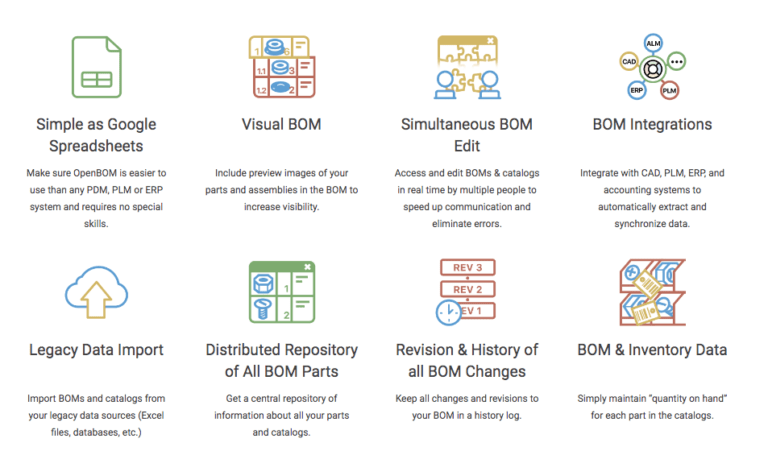
Before, when you wanted to organize RFQ and Purchasing process you should have been starting from capturing all information manually from design and other engineering spreadsheets. But now, engineers can use this simple automatic CAD add-ins pulling data from CAD and using OpenBOM flexible data model which automatically creates all properties and fill it with the data from your assemblies and parts, count them and give you a report.
Do you see how easy that is?
Check these videos
Let’s delve into the transformation your work undergoes before and after integrating OpenBOM.
Previously, your tools demanded intricate installations, databases, and IT support for setup. Now, with OpenBOM, a cloud-based SaaS solution, accessibility is effortless, always updated, and accessible from any location via a web browser.
Before, creating Bills of Materials (BOMs), conducting reporting, and performing calculations required significant effort. However, with OpenBOM, the process seamlessly resembles Excel, concealing complexity behind a modern and intuitive user interface.
In the past, managing BOMs with Excel or outdated tools restricted you to text-based representations. Now, with OpenBOM, visual BOMs automatically incorporate images and assembly previews, streamlining selections and reducing errors.
Previously, importing data from CAD was a manual endeavor. Now, with OpenBOM’s CAD add-in, this process is automated, simplifying the initiation of each BOM directly from CAD.
Before, crafting formulas and conducting rollups in Excel for BOMs was arduous and lacked the necessary complexity. OpenBOM enables hierarchical structure calculations and centralizes part data, facilitating formula adjustments.
With Excel, maintaining structured and flattened BOMs simultaneously was inconceivable. OpenBOM, however, seamlessly transitions between single-level, multi-level, and flattened BOMs.
Traditional data management systems for BOMs often lacked flexibility, constraining the addition of specific data. OpenBOM bridges this gap by combining Excel’s flexibility with structured BOM data management.
Importing data into BOM management systems was previously laborious. With OpenBOM, legacy data is automatically imported from Excel, streamlining migration and integration with other systems.
Gone are the days of sharing BOMs via email attachments. OpenBOM facilitates real-time data sharing and simultaneous updates, eliminating delays and redundancy.
Excel’s limitations in structuring queries like “composed of” and “where used” are overcome with OpenBOM’s automatic full-text search and where-used functions.
Updating data in BOMs from external systems was once manual and challenging. OpenBOM automates data merge and updates with a simple click of the import button.
Finally, engineers were often held responsible for BOM mistakes, leading to costly errors and manual corrections. With OpenBOM, blame is a thing of the past, empowering engineers to work efficiently without fear of retribution.
Join 1000+ engineers using OpenBOM today to escape Excel BOM hell…
Consequences of Sticking with Excel
Think carefully before relying on Excel to manage your BOMsThink carefully before relying on Excel to manage your BOMs It will entail a significant amount of manual labor, time investment, and potential errors. Such inefficiencies can result in substantial costs for your manufacturing business, including delays, incorrect part orders, and endless communication challenges.
Instead, you can subscribe to OpenBOM for a fraction of the cost you currently incur due to mistakes. OpenBOM offers professional subscriptions ranging from $25 to $375, depending on the desired features.
Here’s what you gain with OpenBOM:
1. Access to an online tool via your browser for managing parts, bills of materials, vendors, and purchases.
2. Automatic data extraction from CAD and other systems.
3. Built-in calculations and rollups.
4. Seamless data sharing online or via export to Excel/PDF/CSV formats.
5. Capability to create shopping lists or reports for procurement and purchasing purposes.
All you need to do is register for OpenBOM and purchase a subscription. Here’s how:
1. Navigate to the OpenBOM website at openbom.com and register for free.
2. Purchase a subscription or request a trial using the provided link.
3. Install the CAD add-in for automatic data extraction.
With these simple steps, you’re all set to enjoy the benefits of OpenBOM and streamline your BOM management process.
Continuing to manage your BOMs in Excel every day only perpetuates the problem, resulting in significant time and money losses for your company.
But here’s a special offer just for you. Since you’ve made it this far, I’d like to extend something exclusive to you. For a limited time, we’re offering a complimentary 2-hour consulting and strategy call with me, valued at $500. This session aims to assist you with any inquiries regarding organizing your information and maximizing your use of OpenBOM.
Now, let’s address the issue of risks…
The risk associated with using OpenBOM is minimal. With our monthly subscription model, you have the flexibility to cancel anytime. Essentially, your risk amounts to just $25, equivalent to the cost of a satisfying lunch.
Here’s an exclusive offer tailored just for you.
With this offer, you’ll receive:
1. Access to a comprehensive online tool for effectively managing Bill of Materials, parts, catalogs, vendors, and purchases.
2. Seamless integration allowing for the automatic extraction of bill of materials from CAD files and easy data import from Excel spreadsheets.
3. Advanced capabilities to handle nested (multi-level) BOMs, track changes, manage revisions, perform calculations, and conduct rollups effortlessly.
4. Streamlined data sharing functionality, enabling you to share critical information with everyone involved and eliminating the risks associated with relying on emails and Excel.
5. A complimentary two-hour specialized consulting web meeting, providing you with personalized guidance and insights to optimize your use of the platform.
Don’t miss out on this opportunity to enhance your BOM management process.
Still have questions?
Here are some typical questions engineers are asking me about OpenBOM:
Q- Will it work with my complex CAD assembly
A- Yes, any data can be imported from CAD to OpenBOM
Q- Will it work with my version of CAD system
A- Yes, we support all CAD systems. If a particular version won’t work, we provide a fix asap
Q- Will it work in my country (eg. China, Europe)
A- Yes, OpenBOM is available globally
Q- Will it automatically shares data with everyone who is using OpenBOM
A- NO, the BOM access is secured and ONLY YOU have an access, unless you share it with your colleagues and contractors
Q – Will it share data automatically with my team
A- Yes, Team subscription does it
Q- Will it update BOM once it is extracted from CAD system
A- Yes, BOM will be updated and merged based on changes you do
Q- How do I know, the data is secured and won’t be shared / sold?
A- Read our terms of service and privacy statement online (link)
